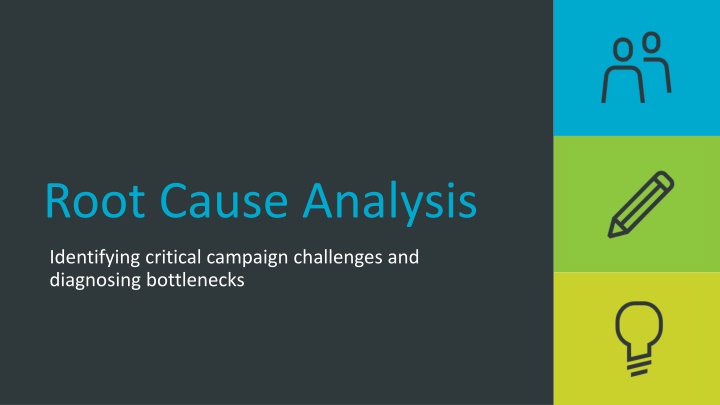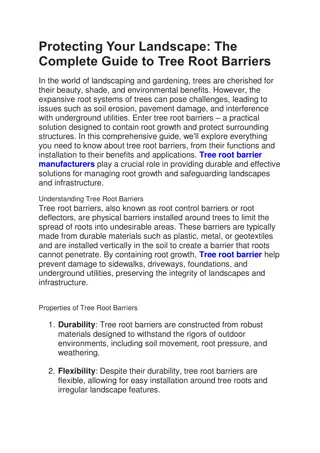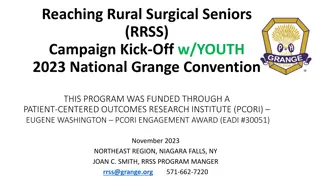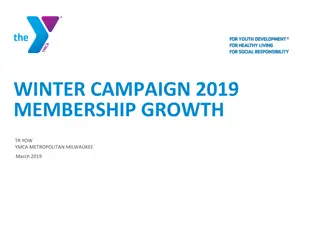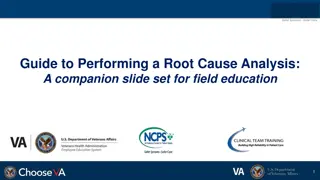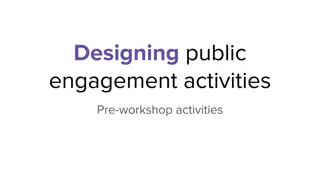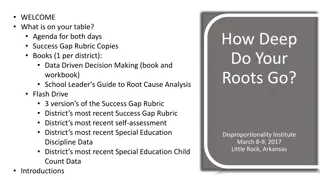Root Cause Analysis for Campaign Challenges
Root Cause Analysis (RCA) is a problem-solving method used to identify underlying causes of key process challenges in campaigns. It helps in learning from bottlenecks and successes to improve future outcomes. This analysis involves understanding what happened, why it happened, and what actions can be taken to enhance effectiveness. The key steps include identifying issues, defining problems, creating RCA diagrams, validating through iterative processes, and prioritizing actionable root causes.
Download Presentation

Please find below an Image/Link to download the presentation.
The content on the website is provided AS IS for your information and personal use only. It may not be sold, licensed, or shared on other websites without obtaining consent from the author.If you encounter any issues during the download, it is possible that the publisher has removed the file from their server.
You are allowed to download the files provided on this website for personal or commercial use, subject to the condition that they are used lawfully. All files are the property of their respective owners.
The content on the website is provided AS IS for your information and personal use only. It may not be sold, licensed, or shared on other websites without obtaining consent from the author.
E N D
Presentation Transcript
Root Cause Analysis Identifying critical campaign challenges and diagnosing bottlenecks
Root Cause Analysis Agenda Introduction to Root Cause Analysis (RCA) Keys steps for conducting root cause analyses Assessing potential impact and actionability of addressing root causes 2
Introduction to Root Cause Analysis 3
What is Root Cause Analysis? A problem-solving method to identify underlying causes of key process challenges A tool for learning from observed bottlenecks and mitigating them in the future & learning from successes and promoting best practices A learning process to determine what happened, why it happened, and what should be done to improve it An iterative approach both hypothesis generating and confirming Why? Why? Why? Root causes Causal factors Causal factors Key Challenge 4
Learning objectives By the end of this module, users should be able to: Understand and describe a common approach to identifying challenges or bottlenecks that may be limiting to the effectiveness of a campaign. Perform a root cause analysis to determine what s causing the challenge or bottleneck. Assess and prioritize root cause(s) that are actionable. 5
Root Cause Analysis Key Steps 6
Overview of the key RCA steps Step 1: Identify issues or bottlenecks Step 2: Define the key problem or challenge (or success) Step 3: Chart the RCA diagram Step 4: Validate the RCA through iterative and participatory processes Step 5: Identify the most impactful and actionable root causes 7
STEP 01 | Identify campaign issues or bottlenecks Brainstorm observed challenges, issues, or bottlenecks Categorize identified challenges into domains to help recognize where challenges are concentrated Draw on multiple sources of data: Planning Routine and non-routine sources Funding Observations from supervision visits Human resources Document review Disease/epidemiological context Key informant interviews and/or focus groups Logistics management Data/monitoring and evaluation Leadership, management, and coordination Intervention characteristics/design Population and patient characteristics Advocacy and social mobilization Contextual factors Social determinants 8
STEP 02 | Define the key problem or challenge (or success) Tips and Considerations Examine your list of challenges which one is most closely related to the desired outcome or impact? For example: Use plain language to ensure clear articulation and understanding of the challenge (or success) by the evaluation team and other relevant stakeholders If measles outbreaks continue to occur after a measles campaign... If multiple challenge statements are identified, some will likely fall along the causal pathway between root cause and overall challenge Potential challenge statement: Measles outbreaks continue to occur Where there are multiple challenges, consider which are most actionable to address If campaign coverage is lower than expected... Potential challenge statement: Low coverage Although challenges are most often the focus of RCA, examining successes as well can facilitate learning and sharing of best practices 9
STEP 03 | Chart the RCA diagram RCA usually involves a visual schematic to document assumed causal chains; flow charts work well Tips and Considerations Work backwards from the prioritized challenge through assumed causal factors to arrive at most likely root cause Probes such as Who, What, Where, When, and How questions help in assessing challenges RCA often performed as a group exercise; drawing on diverse perspectives strengthens the RCA Who were the stakeholders involved? What information was available to key stakeholders? Charting the RCA helps identify evidence gaps and where additional validation is needed Where did the challenge or problem happen? Put everything down on paper first, then investigate and iterate further. Messy is okay! How widespread is the challenge or problem? How well were procedures carried out? Transfer draft RCA to PowerPoint for sharing digitally; use for further iteration and development 5 Whys technique for getting at the root cause 10
EXAMPLE RCA: Human African Trypanosomiasis Elimination Initiative 11
STEP 04 | Validate the RCA through iterative and participatory processes RCA benefits from iteration update and refine your RCA as additional data is collected and analyzed Tips and Considerations Are there other types of data that need to be collected? Identify gaps and make plans for additional data collection A participatory process helps confirm assumptions and linkages in the RCA, causal factors, and the key challenges Consider what contextual and/or environmental factors may be affecting the causal chain A participatory workshop is a low-cost, efficient approach to RCA validation Design choices such as color-coded boxes and solid vs. dotted lines can help convey relationships Engage a variety of stakeholders with diverse perspectives, such as: Ministry of Health officials, district health planners, program managers, implementers, technical partners, and donors Developing a draft RCA prior to the stakeholder workshop helps validate the evaluation team s analyses with stakeholders and uncover additional supporting information Reaching consensus on root cause(s) is critical before moving onto designing solutions/interventions See Participatory Workshop Design Considerations in RCA Toolkit for guidance on carrying out the workshop 12
STEP 05 | Identify most impactful and actionable root causes Identifying actionable and impactful root causes is a critical step prior to intervention design Common considerations for assessing actionability and impact are summarized Feedback on actionability and impact can also be gathered through a participatory workshop Use a 2x2 table to organize which root causes are most actionable, and if addressed, likely to drive the most impact Root causes Low potential impact High potential impact Low actionability High actionability 13
Assessing potential impact and actionability of addressing root causes 14
Considerations to assess potential impact and actionability of addressing root causes 15
Determinants of RCA usefulness Strong engagement with stakeholders key actions must be bought into the RCA causal pathway RCA strikes the right tone in framing challenges and successes A policy or program window exists within which changes can be enacted and adopted RCA is accompanied by actionable recommendations to help frame further discussion on intervention design 17
